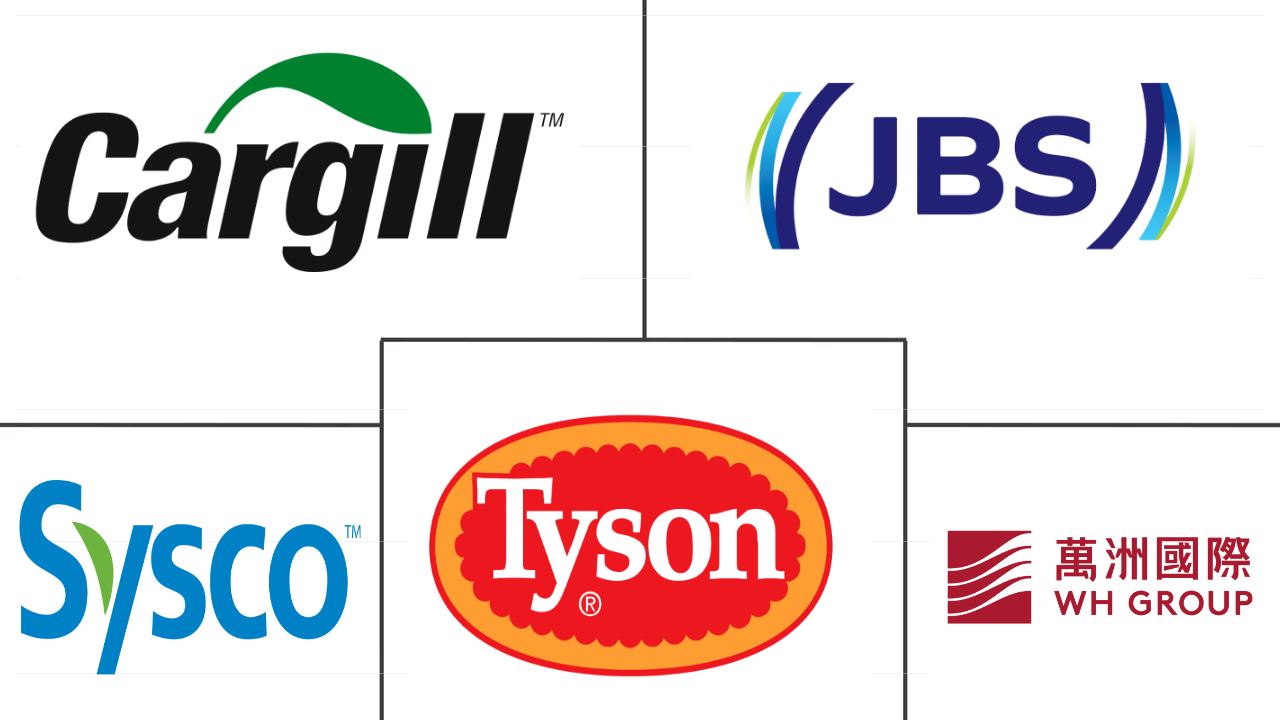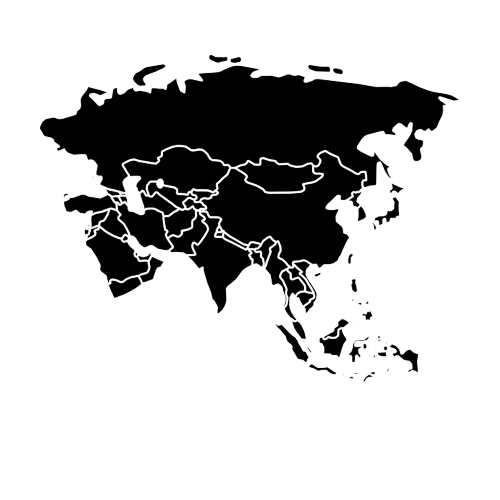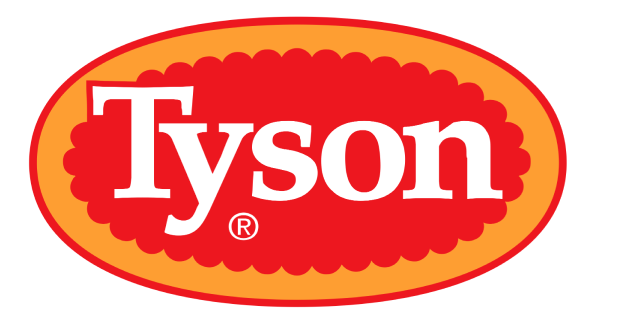Market Size of edible meat Industry
|
|
Study Period | 2017 - 2029 |
|
|
Market Size (2024) | USD 1.25 Trillion |
|
|
Market Size (2029) | USD 1.35 Trillion |
|
|
Largest Share by Type | Pork |
|
|
CAGR (2024 - 2029) | 1.56 % |
|
|
Largest Share by Region | Asia-Pacific |
Major Players |
||

|
||
|
*Disclaimer: Major Players sorted in no particular order |
Edible Meat Market Analysis
The Edible Meat Market size is estimated at 1.25 trillion USD in 2024, and is expected to reach 1.35 trillion USD by 2029, growing at a CAGR of 1.56% during the forecast period (2024-2029).
1.25 Trillion
Market Size in 2024 (USD)
1.35 Trillion
Market Size in 2029 (USD)
3.05 %
CAGR (2017-2023)
1.56 %
CAGR (2024-2029)
Largest Segment by Type
32.02 %
value share, Pork, 2023
Products such as bacon, sausages, and ham have boosted the demand for processed pork items. The growth in demand is due to its growing consumption in breakfast or lunch.
Largest Segment by Region
53.68 %
value share, Asia-Pacific, 2023

Larger production and a broader meat-consuming population make Asia-Pacific dominate the market. China, followed by Japan and South Korea are the top markets in the region.
Fastest-growing Segment by Type
1.79 %
Projected CAGR, Mutton, 2024-2029
Mutton has become the primary protein choice in major regions such as the Middle East and North America and emerging as the default meat type owing to its popularity.
Fastest-growing Segment by Region
3.67 %
Projected CAGR, Africa, 2024-2029
The growth in the per capita income, as well as the population growth in Sub-Saharan Africa, are projected to drive the edible meat market in the forecast period.
Leading Market Player
4.29 %
market share, Tyson Foods Inc., 2022

The company leads the market due to its broad product line, which includes all types of edible meat, and its greater market penetration, which extends to almost all regions.
Increased consumption of pork is driving the market demand
- The global edible meat market is driven by pork consumption, which had the highest growth rate by value in 2022. It is also anticipated that a CAGR of 2.13% will be registered during the forecast period on a value basis. The consumption of pork was largely led by the Asia-Pacific region, with a market share of 68.31% by value in 2022. Pork is considered a staple diet in Asian countries, and consumers usually prefer fresh pork instead of frozen and processed pork. Multiple catering businesses in China, Japan, and Australia are likely to further boost the demand for fresh pork in the future.
- China emerged as the world’s largest consumer of beef, with a market share of 19.35% by value in 2022. In 2022, the Chinese market consumed 8.84 million tons of beef. However, most countries with high beef per capita consumption are likely to witness their level of beef consumption decline in favor of poultry meat.
- Also, the consumption of poultry increased drastically globally during the review period, registering a growth of 16.45% in 2022 compared to 2018. The changing consumption patterns of global consumers toward nutritious and healthy foods are driving poultry consumption. North America is the second-major poultry consumption region, with a share of 20% by value in 2022. The affordability of chicken compared to other meat types makes it an attractive option for consumers, especially those who are looking for cost-effective protein sources.
- The decrease in sheep and lamb production has been accompanied by higher prices, which are responsible for the greater production costs. Mutton was priced 20% higher than any other meat in 2022. Shortages in supply and high prices diminished the consumption of sheep and lamb and prevented their growth.
Increased investment in the meat sector drives market growth
- Edible meat was majorly consumed in the Asia-Pacific region in 2022. From 2019 to 2022, it registered a CAGR of 2.96%. The increased consumption of edible meat resulted in an Asian meat complex, which connects Asian countries and the larger world via meat commodities and their feedstocks. Much of the meat consumed in Southeast Asia is produced locally, primarily through industrialized systems. Large corporations increasingly shape the Asian edible meat market.
- Africa is anticipated to be the fastest-growing region in the edible meat market for the forecast period. It registered a growth of 3.89% in 2022. The consumption of edible meat is growing in Africa, and investment opportunities are likely to be more attractive than in other global regions. Future investments would be required along the entire value chain, including facilities for raising poultry and pork, abattoirs, feed production, transportation, and equipment supply. The demand for poultry products increased drastically due to the increasing number of retail restaurant chains, such as KFC, Steers, Wimpy, and Debonairs.
- The Middle East is the second fastest-growing region in the edible meat market. It is expected to register a growth of 2.28% during the forecast period. In Middle Eastern countries, the meat market is expanding rigorously due to rising meat consumption. In 2022, JBS SA invested USD 2 billion and bought two plants in Saudi Arabia and the United Arab Emirates, specializing mainly in frozen food, including beef and chicken. In 2022, Tyson Foods planned to expand its footprint by investing in a Saudi Arabia-based meat company, acquiring a 15% equity stake in Tanmiah and a 60% equity stake in Supreme Foods Processing Company.
Edible Meat Industry Segmentation
Beef, Mutton, Pork, Poultry are covered as segments by Type. Canned, Fresh / Chilled, Frozen, Processed are covered as segments by Form. Off-Trade, On-Trade are covered as segments by Distribution Channel. Africa, Asia-Pacific, Europe, Middle East, North America, South America are covered as segments by Region.
- The global edible meat market is driven by pork consumption, which had the highest growth rate by value in 2022. It is also anticipated that a CAGR of 2.13% will be registered during the forecast period on a value basis. The consumption of pork was largely led by the Asia-Pacific region, with a market share of 68.31% by value in 2022. Pork is considered a staple diet in Asian countries, and consumers usually prefer fresh pork instead of frozen and processed pork. Multiple catering businesses in China, Japan, and Australia are likely to further boost the demand for fresh pork in the future.
- China emerged as the world’s largest consumer of beef, with a market share of 19.35% by value in 2022. In 2022, the Chinese market consumed 8.84 million tons of beef. However, most countries with high beef per capita consumption are likely to witness their level of beef consumption decline in favor of poultry meat.
- Also, the consumption of poultry increased drastically globally during the review period, registering a growth of 16.45% in 2022 compared to 2018. The changing consumption patterns of global consumers toward nutritious and healthy foods are driving poultry consumption. North America is the second-major poultry consumption region, with a share of 20% by value in 2022. The affordability of chicken compared to other meat types makes it an attractive option for consumers, especially those who are looking for cost-effective protein sources.
- The decrease in sheep and lamb production has been accompanied by higher prices, which are responsible for the greater production costs. Mutton was priced 20% higher than any other meat in 2022. Shortages in supply and high prices diminished the consumption of sheep and lamb and prevented their growth.
| Type | |
| Beef | |
| Mutton | |
| Pork | |
| Poultry | |
| Other Meat |
| Form | |
| Canned | |
| Fresh / Chilled | |
| Frozen | |
| Processed |
| Distribution Channel | ||||||
| ||||||
| On-Trade |
| Region | |||||||||||||||
| |||||||||||||||
| |||||||||||||||
| |||||||||||||||
| |||||||||||||||
| |||||||||||||||
|
Edible Meat Market Size Summary
The edible meat market is experiencing a steady growth trajectory, driven primarily by the increasing consumption of pork, particularly in the Asia-Pacific region, where it is a dietary staple. The region's preference for fresh pork over frozen and processed options is bolstering demand, supported by the expansion of catering businesses in countries like China, Japan, and Australia. Meanwhile, China stands as the largest consumer of beef globally, although there is a noticeable shift towards poultry consumption due to changing dietary preferences for healthier and more affordable protein sources. North America also plays a significant role in poultry consumption, with its affordability making it a popular choice among consumers seeking cost-effective options. However, the sheep and lamb segment faces challenges with high production costs and reduced consumption due to price increases.
The Asia-Pacific region remains the dominant market for edible meat, with significant local production and industrialized systems supporting the supply chain. Africa is projected to be the fastest-growing region, attracting investment opportunities across the value chain, including poultry and pork production facilities. The Middle East is also witnessing rapid market expansion, with substantial investments from major companies like JBS SA and Tyson Foods, aiming to enhance their presence in the region. Global beef production is influenced by various factors, including droughts and demand-driven price increases, particularly in the United States and Brazil. The market is characterized by fragmentation, with major players like Cargill Inc., JBS SA, Sysco Corporation, Tyson Foods Inc., and WH Group Limited holding a significant share. Recent expansions and acquisitions by Tyson Foods highlight the ongoing efforts to meet rising global demand and enhance production capabilities.
Edible Meat Market Size - Table of Contents
-
1. MARKET SEGMENTATION (includes market size in Value in USD, Forecasts up to 2029 and analysis of growth prospects)
-
1.1 Type
-
1.1.1 Beef
-
1.1.2 Mutton
-
1.1.3 Pork
-
1.1.4 Poultry
-
1.1.5 Other Meat
-
-
1.2 Form
-
1.2.1 Canned
-
1.2.2 Fresh / Chilled
-
1.2.3 Frozen
-
1.2.4 Processed
-
-
1.3 Distribution Channel
-
1.3.1 Off-Trade
-
1.3.1.1 Convenience Stores
-
1.3.1.2 Online Channel
-
1.3.1.3 Supermarkets and Hypermarkets
-
1.3.1.4 Others
-
-
1.3.2 On-Trade
-
-
1.4 Region
-
1.4.1 Africa
-
1.4.1.1 By Type
-
1.4.1.2 By Form
-
1.4.1.3 By Distribution Channel
-
1.4.1.4 By Country
-
1.4.1.4.1 Egypt
-
1.4.1.4.2 Nigeria
-
1.4.1.4.3 South Africa
-
1.4.1.4.4 Rest of Africa
-
-
-
1.4.2 Asia-Pacific
-
1.4.2.1 By Type
-
1.4.2.2 By Form
-
1.4.2.3 By Distribution Channel
-
1.4.2.4 By Country
-
1.4.2.4.1 Australia
-
1.4.2.4.2 China
-
1.4.2.4.3 India
-
1.4.2.4.4 Indonesia
-
1.4.2.4.5 Japan
-
1.4.2.4.6 Malaysia
-
1.4.2.4.7 South Korea
-
1.4.2.4.8 Rest of Asia-Pacific
-
-
-
1.4.3 Europe
-
1.4.3.1 By Type
-
1.4.3.2 By Form
-
1.4.3.3 By Distribution Channel
-
1.4.3.4 By Country
-
1.4.3.4.1 France
-
1.4.3.4.2 Germany
-
1.4.3.4.3 Italy
-
1.4.3.4.4 Netherlands
-
1.4.3.4.5 Russia
-
1.4.3.4.6 Spain
-
1.4.3.4.7 United Kingdom
-
1.4.3.4.8 Rest of Europe
-
-
-
1.4.4 Middle East
-
1.4.4.1 By Type
-
1.4.4.2 By Form
-
1.4.4.3 By Distribution Channel
-
1.4.4.4 By Country
-
1.4.4.4.1 Bahrain
-
1.4.4.4.2 Kuwait
-
1.4.4.4.3 Oman
-
1.4.4.4.4 Qatar
-
1.4.4.4.5 Saudi Arabia
-
1.4.4.4.6 United Arab Emirates
-
1.4.4.4.7 Rest of Middle East
-
-
-
1.4.5 North America
-
1.4.5.1 By Type
-
1.4.5.2 By Form
-
1.4.5.3 By Distribution Channel
-
1.4.5.4 By Country
-
1.4.5.4.1 Canada
-
1.4.5.4.2 Mexico
-
1.4.5.4.3 United States
-
1.4.5.4.4 Rest of North America
-
-
-
1.4.6 South America
-
1.4.6.1 By Type
-
1.4.6.2 By Form
-
1.4.6.3 By Distribution Channel
-
1.4.6.4 By Country
-
1.4.6.4.1 Argentina
-
1.4.6.4.2 Brazil
-
1.4.6.4.3 Rest of South America
-
-
-
-
Edible Meat Market Size FAQs
How big is the Global Edible Meat Market?
The Global Edible Meat Market size is expected to reach USD 1246.56 billion in 2024 and grow at a CAGR of 1.56% to reach USD 1346.90 billion by 2029.
What is the current Global Edible Meat Market size?
In 2024, the Global Edible Meat Market size is expected to reach USD 1246.56 billion.

